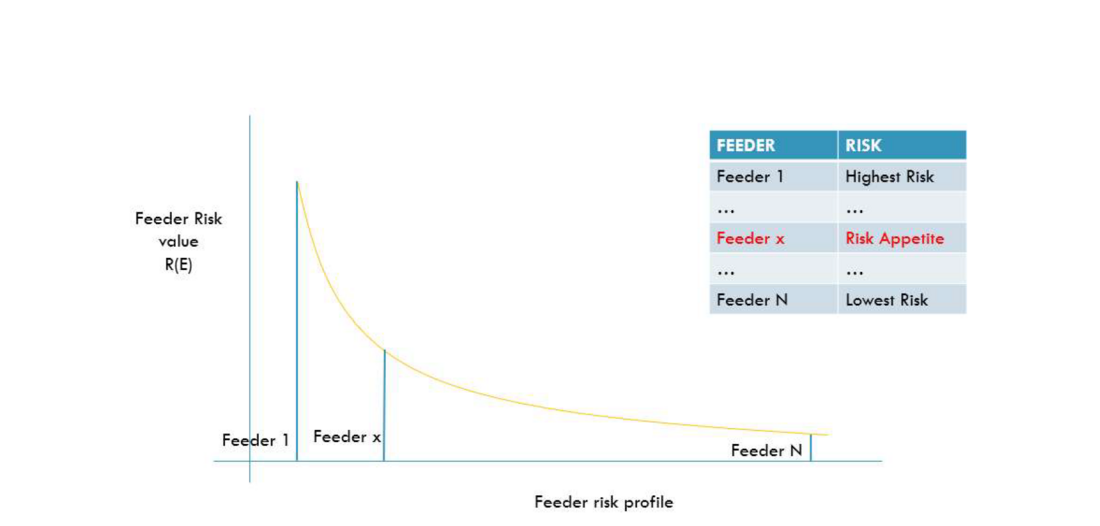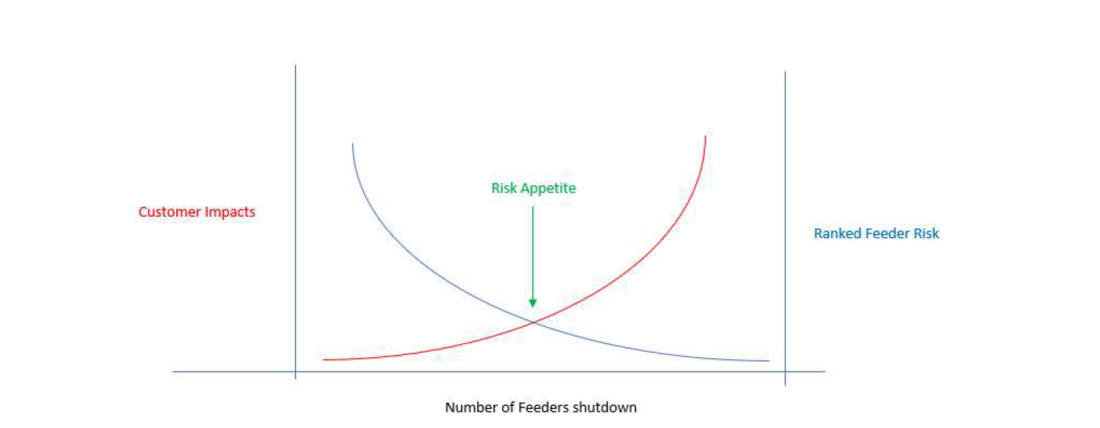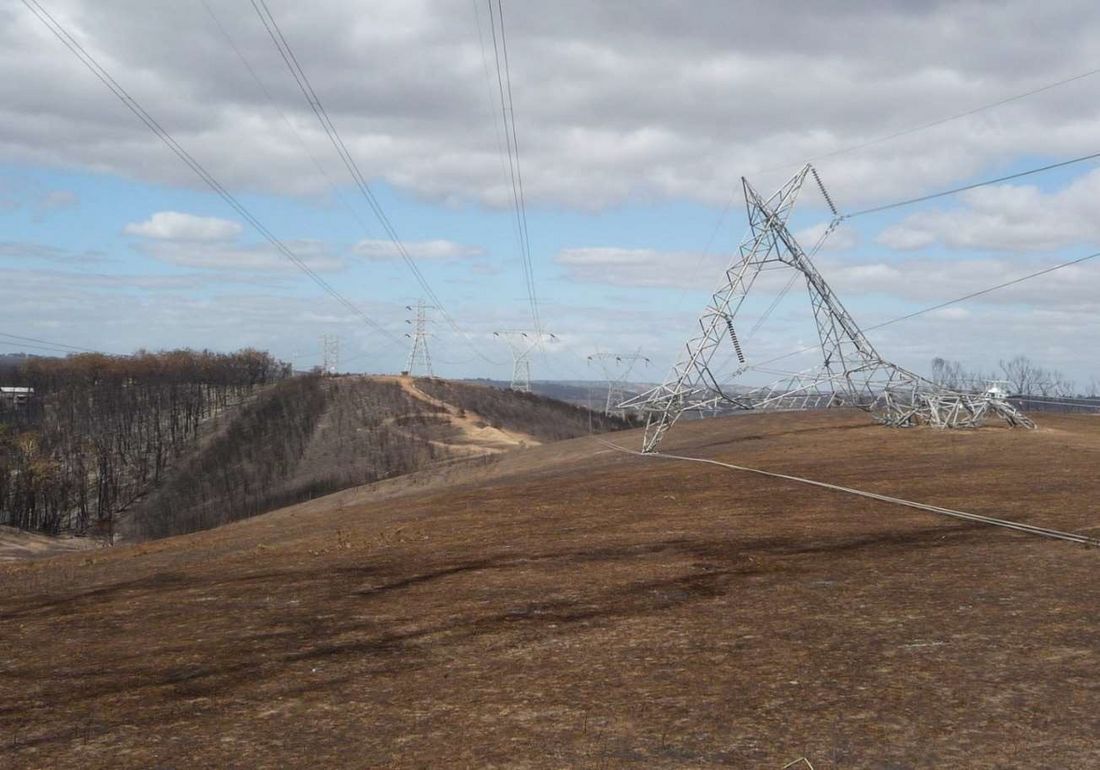Mitigating the risk of fire starts and the consequences of fires near overhead lines for System Operations
History shows that electricity infrastructure has started many wildfires (or “bushfires”) around the world including in the United States and Australia. Since powerlines are often installed to supply customers living in remote and densely vegetated locations, fires caused by electricity infrastructure when fire weather conditions are elevated, are found to result in extreme consequences (Energy Networks Association 2020, Miller et al 2017).
Members
Convenor
(AU)
F. CRISCI
A. MOGILVESKY (CA), J. VACCARO (US), J. RAMIREZ (US), D. RUSSELL (US), A. BEUTEL (SA)
Introduction
With forecasts that Climate Change will increase the number of days of extreme fire danger, as well as the duration and intensity of such days, the imperative for mitigating the risk of fires from powerlines, and understanding the impacts that wildfires have on distribution and transmission lines has never been greater.
The purpose of this study was to investigate the system operating practices of utilities which operate their networks in elevated wildfire danger environments and collate best-practice strategies.
Industry Wildfire Survey
A survey was issued to distribution and transmission utilities which manage significant wildfire risk. For distribution utilities, this is the risk of starting a wildfire. While transmission utilities occasionally start wildfires (Blunt 2019), the main hazard is the need to manage the risk of a wildfire engulfing their lines and affecting grid stability and security.
The aim of the survey was to collate best-practice operating procedures and arrange them into the Prevent, Prepare, Respond, Recover (PPRR) framework of Emergency Management for utilities to then compare and contrast their existing practices against this framework.
Utilities were asked to provide responses to 11 areas of operations:
- Volume of assets and wildland fire risk
- Fire Start Statistics
- The impact of line design/construction standards on operational decision-making
- Impact of Regulatory and legislative frameworks for operational management of fire and weather risk management
- Fires & impacts on electricity grids
- Fuel curing and satellite data
- Environmental management of Transmission Line corridors
- Line easement management practices
- Utility as part of State/National Emergency Management structure
- Air ionization and flashover risk management
- Technology developments
From the survey results, distribution utilities are the ones most concerned with wildfire risk management and consequently most of the study was focused on them. The distribution utilities that are most advanced in wildfire risk mitigation, have implemented multiple strategies for fire start risk mitigation, including:
- Altering protection on elevated fire danger days
- Modelling fire propagation to classify fire risk areas and prioritise fire risk mitigation work
- Detection of incipient-fault technology
- Detection of conductor-break technology
- A decision-making framework for shutting down power
- Commissioning studies into fire behaviour
- Working closely with fire-fighting agencies on elevated fire danger days
To better understand their risks, utilities undertake wildfire risk modelling to calculate potential consequences from fires started from their powerlines, under a range of weather patterns and fuel volumes and fuel curing. This then informs them on potential consequences or threats from such fires.
When coupled with data on powerline fire starts, utilities then identify trends in fire start causes and grade their service areas typically into a multi-level risk classification system such as high risk, medium risk and low risk.
This risk classification then drives asset replacement programs, the frequency of wildfire asset inspection programs and maintenance priorities, as well as how they operate their powerlines in the different risk areas on elevated fire danger days.
A number of the utilities surveyed have commissioned studies by academic and scientific organisations, into fire start mechanisms and fire propagation. The results of such research has informed utilities to refine or fundamentally change their fire risk mitigation practices.
Some utilities have recognised the importance of working closely with fire-fighting agencies, for which there are mutual benefits. Fire agencies can assist utility personnel to safely enter fire grounds to commence inspection and repair work after the passage of a fire, and utility personnel can switch off and isolate downed powerlines to allow fire-fighting agencies to safely fight fires.
Conscious of the fire start potential, on elevated fire danger days, many distribution utilities alter protection settings on feeder circuits by either disabling reclosing, or making protection settings more sensitive, or both. One study suggests that altering protection settings in this way can provide a potential 16% reduction in probability of ignition on multi-phase distribution systems (Dunstall et al 2016, p. 47).
Following the 2009 Black Saturday bushfires in the state of Victoria, Australia, utilities in that state have installed plant which interrupts a phase-to-earth fault within milliseconds, thereby arresting the fault energy and potentially reducing the risk of a fire starting. This technology is referred to as Rapid Earth Fault Current Limiter (REFCL) technology. Recent analysis of the benefits of REFCL concluded that there were uncertainties in the risk reduction rate and uncertainty in the quantification of the benefits due to the cost and probability of an extreme fire (Nous Group 2020).
A technology developed in the United States, called Distribution Fault Anticipation, aims to detect incipient faults so that utilities can repair the defect before it evolves into a fault (Wischkaemper et al 2015). A similar technology, referred to as Early Fault Detection, has been developed in Australia (Wong et al 2019).
These technologies provide utilities with the opportunity to intervene on an emerging component failure. If such a failure were to occur on an elevated fire danger day, a fire could start with catastrophic consequences. Hence these technologies also provide utilities with the potential to shut down a faulty feeder circuit, on an elevated fire danger day, before a catastrophic failure occurs.
However, there is minimal reporting available of the use of this technology on elevated fire danger days.
Another technology being investigated in the USA is the Conductor Break technology where a broken conductor is detected, and the circuit is de-energised before the conductor hits the ground (O’Brien 2016). However, the investigators of the study state that:
It’s expensive when applied to circuits having only legacy protection and control schemes, requires specialized communication between recloser switches and the ability to coordinate the response communications, and does not pick up the case when the conductor falls to the ground and remains intact.
A similar technology is being investigated in Australia [1].
To reduce the risk of conductor clashing or vegetation interference, distribution utilities are also replacing bare conductors with covered or insulated conductors as shown in Figure 1.

Figure 1 - Covered and insulated conductors
Bare powerlines can also be replaced with underground cables. However, the costs of overhead high voltage insulated bundled cables is at least twice the costs of bare high voltage lines, while the costs of undergrounding lines can be around seven times and up to ten times the costs of bare construction.
One utility surveyed is investigating micro-grids (Hering 2019). Micro-grids are becoming more practical and could be particularly applied for small load centres serviced by long distribution lines which would be replaced with local generation and energy storage systems.
The minimum wildfire risk management activity undertaken by utilities includes regular inspection and
maintenance of their distribution plant and clearing vegetation from around their assets. The survey found that the extent of vegetation clearing requirements varies considerably. For example, for lines operating at 72 kV in California, the minimum clearance of vegetation from powerlines is 1.22 m, while in the state of Victoria, Australia, the horizontal and vertical clearances for a 250 m span on a line operating at 66 kV are 2.75 m [2], and in South Australia for the same span length the clearances are 6.5 m horizontally and 3 m vertically.
The regulatory regimes that utilities work within substantially affect their business operations. This is particularly true for the legislated authority for power shutdowns to mitigate wildfire start risk.
One utility surveyed has legislated authority to shut off power, with immunity from prosecution, if it forms the opinion that it’s necessary to do so to avert danger to person or property (Electricity Act 1996). Utilities in California also have legislated authority to pre-emptively shut down power.
However, the California Public Utilities Commission has imposed strict requirements on utilities regarding community notifications and power shut down event reporting (California Public Utilities Commission 2018), as well as a requirement to demonstrate that the shutdown was effectively the strategy of last resort (California Public Utilities Commission 2021).
The rule of “Inverse Condemnation” which applies in California, makes utilities liable for any damages caused by their activity or equipment, regardless of fault or foreseeability (Zurcher 2020). Coupled with an increasing frequency of major events with commensurate large payouts (Balaraman 2021), utilities in California are increasingly implementing the pre-emptive power shutdown strategy (Hering 2020). This trend is unlikely to wane given the forecast that climate change will increase the number and severity of wildfire risk conditions (Perkins-Kirkpatrick 2020, Hannam 2020).
However, shutting off power has drastic impacts on the served communities. Studies have shown that during heatwaves, the rate of fatalities increases markedly (Nairn et al 2013); shutting down power would potentially exacerbate the number of fatalities in a heatwave.
Consequently, utilities who use power shutdowns for wildfire risk management, will need to establish a “Risk Appetite” level which balances mitigating the risk of starting a wildfire against the adverse impact that power shutdowns have on the served community.
Figure 2 shows a Feeder Risk Profile. Using utility fire start likelihood statistics and fire consequence modelling, feeder fire risks are calculated and ranked from highest risk to lowest risk. The utility then works out its Risk Appetite level by determining the point where the accumulated ranked feeder risk profile balances the Customer Impacts.
Customer Impacts can be gleaned from regulated service performance targets and values attributed by customers to interruption of their supply [Longo et al 2018, Australian Energy Market Commission 2009). This is referred to as the “Inconvenience Factor” which is a financial representation of the inconvenience caused to customers from having their supply interrupted.
The utility risk appetite is nominally the point where the cumulative ranked feeder risk of “F” feeders balances the Customer Impact of shutting down F feeders – refer to Figure 3.

Figure 2 - Feeder Risk Profile – feeder risks ranked from highest risk to lowest risk

Figure 3 - Risk Appetite – where accumulated Ranked Feeder Risk balances Customer Impacts
The utility also needs to have regard to its insurance arrangements in calculating its risk appetite.
With reference to Figure 4, in determining the balance point, utilities need to consider:
- FRi is the Feeder Risk of the ith feeder
- Cust Numi is the number of customers supplied by the ith Feeder
- Outage Durationi is the duration of the power shutdown for Feederi
- IFi is the “Inconvenience Factor” for Feederi

Figure 4 - balancing feeder risk and Customer impacts
Transmission lines [3] occasionally start wildfires (Blunt 2019). However, transmission utilities are more likely to be impacted by wildfires, sometimes structurally – refer to Figure 5 – but more often through interconnector system security and stability (ENTSO-E 2021).

Figure 5 - Transmission line impacted by bushfire is Australia
A number of transmission system disturbance events are reported in this study, initiated by wildfires engulfing transmission lines. However, not all transmission utilities surveyed disable reclose on transmission lines when a wildfire is in the vicinity.
The study proposes some strategies for new transmission line construction, to mitigate the risk of adverse impact from wildfires such as avoiding areas of high volumes of fuel load and high wildfire history.
Finally, the need for transmission utilities and fire-fighting agencies to collaborate during wildfire events is highlighted by an incident in which a fire fighter was knocked to the ground as a result of step potential from a flashover on a 500 kV line (TB 767 - 2019).
Conclusion
In this study, transmission and distribution utilities were surveyed on their practices for mitigating wildfire start risk and the consequences of wildfires near and around overhead lines.
From this survey, best practice strategies have been collated using an Emergency Management (EM) framework which addresses practices to:
- Prevent wildfire risk,
- Prepare for elevated fire danger days,
- Respond to elevated fire danger days and
- Recover from wildfires that may occur on elevated fire danger days.
A number of these wildfire mitigation practices can be applied by both transmission and distribution utilities. The survey shows that distribution utilities are more likely to start fires, while transmission utilities can be adversely affected by wildfires traversing their Rights of Way.
Distribution utilities are collaborating with universities, research groups and equipment vendors to investigate and implement strategies for mitigating the risk of starting bushfires from their assets.
The study has demonstrated that utilities which have implemented a sound Emergency Management framework for bushfire risk management, are least likely to start bushfires, and are least likely to be adversely impacted by bushfires burning around their transmission lines.
Given the impacts of climate change, more utilities will need to consider bushfire risk mitigation. This study provides those utilities with a collation of best practice bushfire risk management strategies, and hence a starting point for considering improvements to their current operations.
References
- Miller, C. et al, (2017), ‘Electricity caused wildfires in Victoria, Australia are over-represented when fire danger is elevated’, Landscape and Urban Planning 167 (2017), pp. 267-274
- Voice of America, (2020), ‘California could mandate backup power at cell phone towers’, Herald Globe, 9 January 2020, Volume No. 0205/16
- Blunt K. and Gold R. (2019),’PG&E delayed safety work on powerlines that is prime suspect in California wildfire’, The Wall Street Journal Feb 27, 2019, https://www.wsj.com/articles/pg-e-delayed-safety-work-on-power-line-that-is-prime- suspect-in-california-wildfire-11551292977 viewed on 25 June 2019
- Collins et al (2016), ‘Some Wildfire Ignition Causes Pose More Risk of Destroying Houses than Others’, PLOS ONE | DOI:10.1371/journal.pone.0162083 September 6, 2016
- Perkins-Kirkpatrick, S.E. & Lewis, S.C. (2020), “Increasing Trends in regional heatwaves”, NATURE COMMUNICATIONS | (2020) 11:3357 | https://doi.org/10.1038/s41467-020-16970- 7 | www.nature.com/naturecommunications
- Dunstall et al (2016), ‘PBSP Risk Reduction Model’, CSIRO Data61, Australia, prepared for Victorian Government Powerline Bushfire Safety Program, https://www.energy.vic.gov.au/ data/assets/pdf_file/0027/424629/for-web-Risk- Reduction-Model-Report-CSIRO.pdf as viewed on 25 January 2022
- Wischkaemper, J. A., Benner, C. L., Russell, B. D., and Manivannan, K., "Application of Waveform Analytics for Improved Situational Awareness of Electric Distribution Feeders," Smart Grid, IEEE Transactions on, vol. 6, pp. 2041-2049, 2015
- K. L. Wong, T. Marxsen, M. Liang and J. S. Chahal (2019), "A Novel Autonomous Technique for Early Fault Detection on Overhead Power Lines," 2019 IEEE 4th International Conference on Condition Assessment Techniques in Electrical Systems (CATCON), 2019, pp. 1-5, doi: 10.1109/CATCON47128.2019.CN0027
- Russell, D., Benner C. and Peterson, R (2020), ‘Fault Anticipation Improves Operations’, Lord Power Equipment website, https://www.lordpowerequipment.com/dfa/bushfire- prevention/497-fault-anticipation-improves-operations as viewed on 30 March 2022
- PSC Group Company (2020), ‘REFCL Functional Performance Review’, Report for Energy Safe Victoria, https://esv.vic.gov.au/safety-education/bushfire-and-powerline-safety/powerline- bushfire-safety-commitee/rapid-earth-fault-current-limiters-refcl-survey-of-selected-hv- sites/ viewed on 28 February 2021
- Marxsen, T. (2015),’Powerline Bushfire Safety Program – REFCL Technologies Test Program – Final Results’, https://www.energy.vic.gov.au/ data/assets/pdf_file/0021/41709/PBSP- REFCL-technologies-Kilmore-final-report-151204.pdf viewed on 28 February 2021
- Nous Group (2020), ‘REFCL cost-benefit analysis’, report for Energy Safe Victoria, REFCL cost- benefit analysis (esv.vic.gov.au) as viewed on 28 January 2022
- O’Brien, W. et al (2016),’Catching Falling Conductors in Midair – Detecting and Tripping Broken Distribution Circuit Conductors at Protection Speeds’, Paper presented at 69th Annual Conference for Protective Relay Engineers, IEEE 20160215 . TP6706-01 https://doi.org/10.1109/CPRE.2016.7914881
- Zurcher, S. (2020), ‘Wildfires are Ravaging California. Can Electric Utilities Take the Heat?’, https://legal-planet.org/2020/10/05/guest-contributor-samantha-zurcher-the-current-state- of-wildfire-liability-in-california/
- California Public Utilities Commission (2021), ‘Decision Adopting Phase 3 Revised and Additional Guidelines and Rules for Public Safety Power Shutoffs (Pro-Active De- energizations) of Electrical Facilities to Mitigate Wildfire Risk Caused by Utility Infrastructure’, Issued 6/29/2021, Rulemaking 18-12-005, Decision 21-06-034
- Balaraman, K. (2021), ‘SCE settles 2018 wildfire insurance claims for $2.2B, faces potential fines over energy efficiency program’, UTILITY DIVE SCE settles 2018 wildfire insurance claims for $2.2B, faces potential fines over energy efficiency program | Utility Dive published on 26 January 2021
- Hering, G. (2019),’California braces for precautionary blackouts as wildfire season begins’, S&P Global Market Intelligence, available online at https://www.spglobal.com/marketintelligence/en/news-insights/trending/5Z1q71TKsUqh4UA68ezPHA2, 4 Jun 2019, viewed on 21 Apr 2020
- Nairn, J. and Fawcett, R. (2013), ‘Defining heatwaves: heatwave defined as a heat-impact event servicing all community and business sectors in Australia’, Centre for Australian Weather and Climate Research (CAWCR), CAWCR Technical Report No. 060
- Perkins-Kirkpatrick, S.E. & Lewis, S.C. (2020), “Increasing Trends in regional heatwaves”, NATURE COMMUNICATIONS | (2020) 11:3357 | https://doi.org/10.1038/s41467-020-16970- 7 | www.nature.com/naturecommunications
- Hannam, P. (2020), ‘Year of extremes as record heat, fire danger and dismal rainfall dominate’, Sydney Morning Herald January 9, https://www.smh.com.au/environment/weather/year-of-extremes-as-record-heat-fire- danger-and-dismal-rainfall-dominate-20200108-p53psq.html viewed on 30 January 2021
- California Public Utilities Commission Resolution (2018), ‘Extending De-energisation reasonableness, notification, mitigation and reporting requirements in decision 12-04-024 to all electric investor owned utilities’, Resolution ESRB-8, July 12, 2018, Date of Issuance: July 16, 2018 https://docs.cpuc.ca.gov/publisheddocs/published/g000/m218/k186/218186823.pdf
- Electricity Act (1996), ‘An Act to regulate the electricity supply industry; to make provision for safety and technical standards for electrical installations; and for other purposes, in the state of South Australia’, Electricity Act 1996 (legislation.sa.gov.au) Version: 4.10.2018, Published under the Legislation Revision and Publication Act 2002
- Miller, C. et al, (2017), ‘Electricity caused wildfires in Victoria, Australia are over-represented when fire danger is elevated’, Landscape and Urban Planning 167 (2017), pp. 267-274
- ENTSO-E (2021), ‘Continental Europe Synchronous Area Separation on 24 July 2021’, Technical Report, Factual Report on the Separation of the Continental Europe Synchronous Area on 24 July 2021 (entsoe.eu) as viewed on 28 January 2022
- Longo, A., Boumand, T, Giccaria, S and Efthimiadis, T (2018),’Societal appreciation of energy security: Volume 1: Value of Lost Load – residential consumers (EE, NL and PT)’, Publicatis Office of the European Union, Luxembourg, 2018, ISBN 978-92-79-98282-8, doi:10.2760/139585, JRC112728 https://publications.jrc.ec.europa.eu/repository/handle/JRC112728#:~:text=The%20Value%20of%20Lost%20Load,conditions%20of%20an%20energy%20system as viewed on 30 March 2022
- Australian Energy Market Commission (2009), ‘NEM Reliability Settings: VOLL, CPT and Future Reliability Review’, Reference ERC0080, https://www.aemc.gov.au/rule-changes/nem- reliability-settings-voll%2C-cpt-and-future-reli as viewed on 30 March 2022
- Longo, A, Boumand, T, Giccaria, S and Efthimiadis, T (2018),’Societal appreciation of energy security: Volume 1: Value of Lost Load – residential consumers (EE, NL and PT)’, Publicatis Office of the European Union, Luxembourg, 2018, ISBN 978-92-79-98282-8, doi:10.2760/139585, JRC112728 https://publications.jrc.ec.europa.eu/repository/handle/JRC112728#:~:text=The%20Value%20of%20Lost%20Load,conditions%20of%20an%20energy%20system as viewed on 30 March 2022
- Energy Networks Australia (2020) ‘Bushfire Factsheet January 2020’, Energy Networks https://www.energynetworks.com.au/resources/fact-sheets/bushfire-factsheet-2020/ as viewed on 30 March 2022





